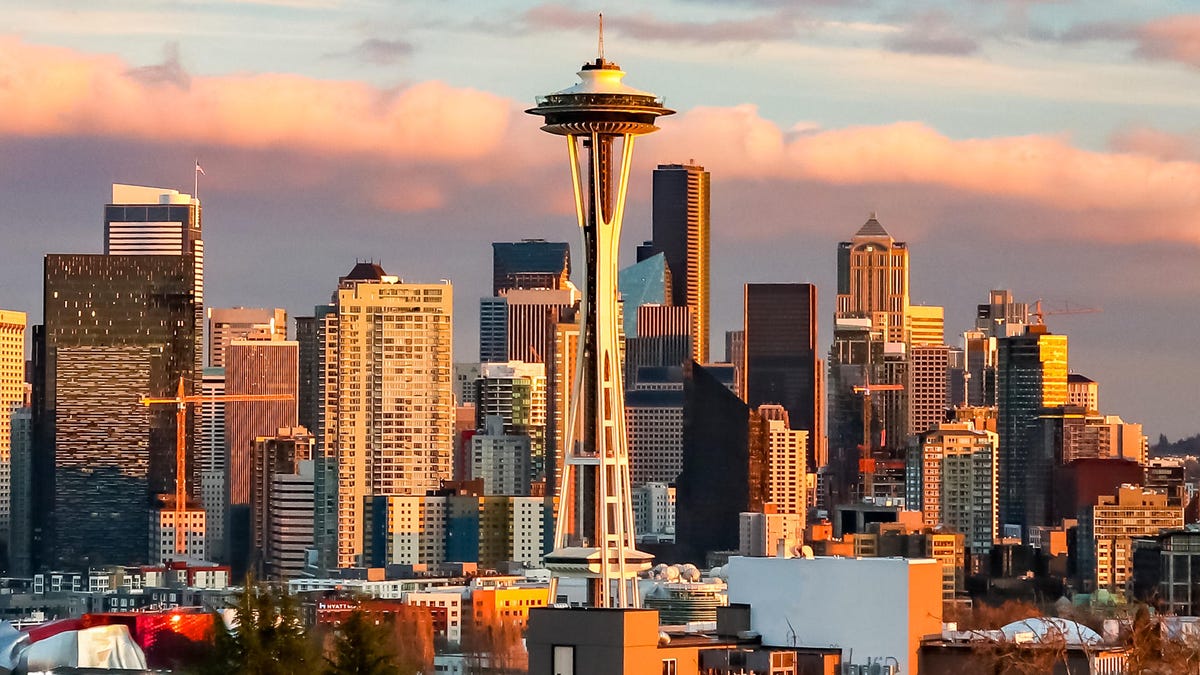 Why You Can Trust CNET
Why You Can Trust CNET A tower for the Space Age: Exploring Seattle's beautiful Space Needle
The Space Needle is a symbol of the city and an iconic design. Here's how it looks up close, and the amazing view from the top.

"Googie." It's not a misprint, it's an architectural style.
You might not know the name, but you'll probably recognize it. A subset of Mid-century modern architecture, you've seen it in such movies as The Incredibles and TV shows like The Jetsons. Googie is rocket-inspired geometric designs featuring atoms, UFOs, boomerangs and anything with an intrinsic sense of motion. Perhaps the most recognizable example is the unofficial symbol of the city of Seattle: The Space Needle.
Built for the Seattle World's Fair in 1962, the 605-foot (184-meter) tower was built to withstand earthquakes greater than 9.0 and category-5 hurricane winds. It has been visited by over 63 million people, including me.
Here's a look inside, and the excellent views from the observation deck.
Seattle stunner
For some reason, I decided to walk. I'd just arrived via ferry after photographing the USS Turner Joy on the other side of Puget Sound. It didn't seem that far on Google Maps , but of course, Google Maps doesn't (yet) tell you that there are hills.
When I finally arrived at the tower its size dominated the views. Briefly the tallest building west of the Mississippi, it is far shorter than more modern towers, like the Tokyo Skytree.
That design, though. Like many once-modern designs, Googie became dated before it became retro, so precious few of these buildings still exist. Los Angeles still has a bunch, an important part of the city's relatively short architectural history. The New York's World's Fair from two years later had most of its buildings removed, and some still exist. Of those still in Queens several are rotting away. The Tomorrowlands at the American Disney parks still have some Googie-inspired buildings, but the newer parks generally don't.
Here in Seattle, the Needle is in a sort of Googie oasis. The towering glass-and-steel skyscrapers are farther south, at a respectable distance, allowing the Space Needle to still have incredible views and not seem tiny compared to modern engineering.
I buy my ticket and head up. Clouds on the horizon mean we'll miss the moment of sunset, but the view is fantastic regardless. There's not much to explore on the observation deck, it's not that big. The original idea was for a floating restaurant, and in terms of size that's basically what this feels like, a big restaurant. Outside there are high glass walls, with tilted glass benches that let you lean back if your vertigo allows.
If you head down the wood- and glass-lined "Oculus" staircase, you get to the lower level. Here, in addition to the restaurant, is a heavily reinforced glass floor that will also rotate. I leave as the tower closes for the night.
The next day I head back, taking the monorail that was also built for the World's Fair. It, too, is an anachronism of another age. The cars are original, but are in good shape. The daytime view is perhaps not quite as epic as the night, but still impressive.
Three Tiny Planets from the observation deck of the Space Needle. From my Instagram.
I check my map, and extrapolate from a few Instagram photos, where on the nearby hill I'd have to head to get a good view of the Needle and the city behind. Kerry Park seems easiest, and closest to a bus line. No way I'm walking up there. The view doesn't disappoint. I return a few hours later, after dinner with a high school friend I haven't seen in 20 years. This trip was a pretty good idea. The Space Needle lit at night is simply gorgeous.
Spacebound
As one of the most visited attractions on the West Coast, you don't need me to tell you it's a great spot. You can buy your tickets ahead of time, which is a bit of a gamble. Seattle is notorious for its cloud cover and regular drizzle, but on the other hand in the summer I can imagine the best times sell out. I'll leave that decision up to you. If you can, arrive about an hour before sunset, then stay to see the lights of the city at night.
The Space Needle's height may no longer be impressive, but the whole point of a tower like this is for a good view, and you can still get that, not to mention the great view looking at it on the ground.
To see how it looks up close, and the excellent views from the observation deck, check out the gallery above.
As well as covering audio and display tech, Geoff does photo tours of cool museums and locations around the world, including nuclear submarines, aircraft carriers, medieval castles, epic 10,000-mile road trips and more.
Also check out Budget Travel for Dummies, his travel book, and his bestselling sci-fi novel about city-size submarines. You can follow him on Instagram and YouTube.

